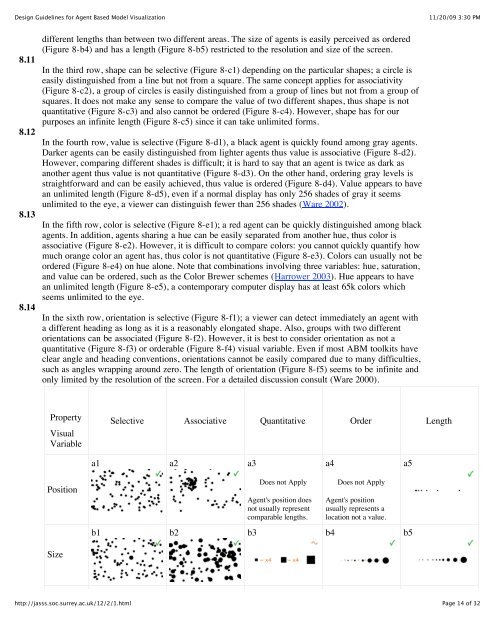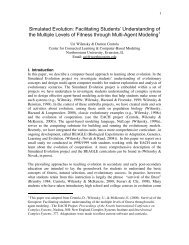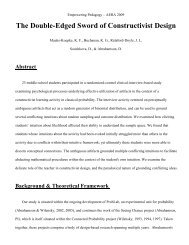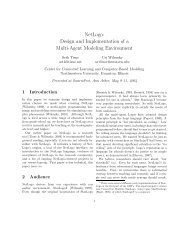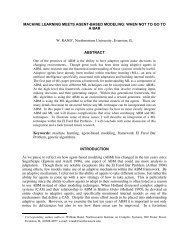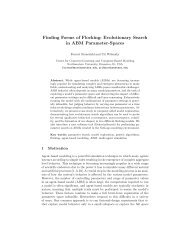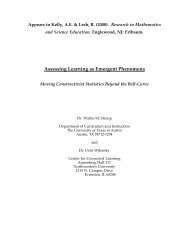Design Guidelines for Agent Based Model Visualization
Design Guidelines for Agent Based Model Visualization
Design Guidelines for Agent Based Model Visualization
Create successful ePaper yourself
Turn your PDF publications into a flip-book with our unique Google optimized e-Paper software.
<strong>Design</strong> <strong>Guidelines</strong> <strong>for</strong> <strong>Agent</strong> <strong>Based</strong> <strong>Model</strong> <strong>Visualization</strong><br />
8.11<br />
8.12<br />
8.13<br />
8.14<br />
different lengths than between two different areas. The size of agents is easily perceived as ordered<br />
(Figure 8-b4) and has a length (Figure 8-b5) restricted to the resolution and size of the screen.<br />
In the third row, shape can be selective (Figure 8-c1) depending on the particular shapes; a circle is<br />
easily distinguished from a line but not from a square. The same concept applies <strong>for</strong> associativity<br />
(Figure 8-c2), a group of circles is easily distinguished from a group of lines but not from a group of<br />
squares. It does not make any sense to compare the value of two different shapes, thus shape is not<br />
quantitative (Figure 8-c3) and also cannot be ordered (Figure 8-c4). However, shape has <strong>for</strong> our<br />
purposes an infinite length (Figure 8-c5) since it can take unlimited <strong>for</strong>ms.<br />
In the fourth row, value is selective (Figure 8-d1), a black agent is quickly found among gray agents.<br />
Darker agents can be easily distinguished from lighter agents thus value is associative (Figure 8-d2).<br />
However, comparing different shades is difficult; it is hard to say that an agent is twice as dark as<br />
another agent thus value is not quantitative (Figure 8-d3). On the other hand, ordering gray levels is<br />
straight<strong>for</strong>ward and can be easily achieved, thus value is ordered (Figure 8-d4). Value appears to have<br />
an unlimited length (Figure 8-d5), even if a normal display has only 256 shades of gray it seems<br />
unlimited to the eye, a viewer can distinguish fewer than 256 shades (Ware 2002).<br />
In the fifth row, color is selective (Figure 8-e1); a red agent can be quickly distinguished among black<br />
agents. In addition, agents sharing a hue can be easily separated from another hue, thus color is<br />
associative (Figure 8-e2). However, it is difficult to compare colors: you cannot quickly quantify how<br />
much orange color an agent has, thus color is not quantitative (Figure 8-e3). Colors can usually not be<br />
ordered (Figure 8-e4) on hue alone. Note that combinations involving three variables: hue, saturation,<br />
and value can be ordered, such as the Color Brewer schemes (Harrower 2003). Hue appears to have<br />
an unlimited length (Figure 8-e5), a contemporary computer display has at least 65k colors which<br />
seems unlimited to the eye.<br />
In the sixth row, orientation is selective (Figure 8-f1); a viewer can detect immediately an agent with<br />
a different heading as long as it is a reasonably elongated shape. Also, groups with two different<br />
orientations can be associated (Figure 8-f2). However, it is best to consider orientation as not a<br />
quantitative (Figure 8-f3) or orderable (Figure 8-f4) visual variable. Even if most ABM toolkits have<br />
clear angle and heading conventions, orientations cannot be easily compared due to many difficulties,<br />
such as angles wrapping around zero. The length of orientation (Figure 8-f5) seems to be infinite and<br />
only limited by the resolution of the screen. For a detailed discussion consult (Ware 2000).<br />
Property<br />
Visual<br />
Variable<br />
Position<br />
Size<br />
http://jasss.soc.surrey.ac.uk/12/2/1.html<br />
Selective Associative Quantitative Order Length<br />
a1 a2 a3<br />
Does not Apply<br />
<strong>Agent</strong>'s position does<br />
not usually represent<br />
comparable lengths.<br />
a4<br />
Does not Apply<br />
<strong>Agent</strong>'s position<br />
usually represents a<br />
location not a value.<br />
b1 b2 b3 b4 b5<br />
a5<br />
11/20/09 3:30 PM<br />
Page 14 of 32


